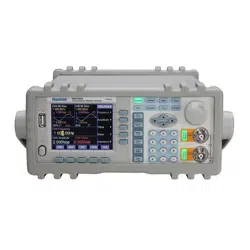Loading ...
Loading ...
Loading ...

frequency units to confirm the new data input. In the amplitude modulation mode, the signal of Channel A is the
carrier signal and the carrier frequency is the frequency of Channel A.
3.7.2 Set the Modulation Frequency
Select “Mod Freq” option by the corresponding soft key. The modulation frequency value changes to yellow.
Input a new modulation frequency data here by numeric keypad or rotary dial. Press the soft key corresponding to
the frequency units to confirm the new data input. In the amplitude modulation mode, the signal of Channel B is
the modulation signal and the modulation frequency is the frequency of Channel B. Generally, the carrier
frequency is at least 10 times higher than the modulation frequency.
3.7.3 Set the Amplitude Modulation Depth
Select “AM Depth” option by the corresponding soft key. The amplitude modulation depth value changes to
yellow. Input a new modulation depth data here by numeric keypad or rotary dial. Press the soft key
corresponding to [%] to confirm the new data input. In the amplitude modulation mode, the amplitude of the
carrier signal varies periodically with the modulation signal. The modulation depth represents the variation in the
carrier signal.
For example, the 100% modulation depth represents that the maximum amplitude of modulation signal is 100% of
the set value, the minimum amplitude of modulation signal is 0% of the set value, i.e. 100% - 0% = 100%. The
0% modulation depth represents that both maximum and minimum amplitude of modulation signal are 50% of the
set value, i.e. 50% - 50% = 0%. Similarly, the 120% depth is 110% - (-10%) = 120%. The modulation depth has
another expression: If the maximum modulation peak-to-peak value is A, the minimum peak-to-peak value is B,
then the modulation depth is expressed as:
DEPTH% = 100× (A-B)/ (A+B)
Actually these two kinds of expressions are the same. However, the second one is easier to understand.
In the amplitude modulation demonstration, in order to clearly observe the amplitude variation, the modulation
depth is set to a relative big value even greater than 100%. But in the practices, in order to avoid the distortion of
the modulation signal, the modulation depth is generally set to less than 50%. This kind of modulation carrier is
called the double-side carrier. Most of the middle-wavelength radio stations use this modulation.
3.7.4 Set the Modulation Waveform
Since the signal of channel B as the modulation signal, the Channel B waveform is actually the modulated
waveform. Select “Mod Wave” option by the corresponding soft key. The index number changes to yellow. Enter
the correct index number by numeric keypad or rotary dial to select a waveform. Press the key corresponding to
[No.] to confirm the index number input. The function generator outputs the desired modulated signal.
3.7.5 External Modulation
The amplitude modulation and frequency modulation can use the external modulation signal. There is a
“Modulation In” connector on the rear panel to import external signal. Select “Mod Wave” option by the
corresponding soft key, press the same key again to select “External”. The internal modulation is automatically
shut off. The frequency of external modulation signal should be compatible to the carrier frequency. The
amplitude of external modulation signal should be adjusted according to frequency modulation deviation or
amplitude modulation depth. The bigger amplitude of external modulation signal is, the bigger frequency
modulation deviation or the bigger amplitude modulation depth will be. In external modulation mode, the keypad
- 19 -
Loading ...
Loading ...
Loading ...
